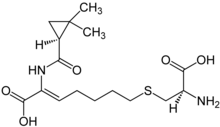Cilastatin
Cilastatin je organsko jedinjenje, koje sadrži 16 atoma ugljenika i ima molekulsku masu od 358,453 Da.[1][2][3]
 | |
 | |
| Klinički podaci | |
|---|---|
| Drugs.com | Monografija |
| Identifikatori | |
| CAS broj | 82009-34-5 |
| ATC kod | None |
| PubChem | CID 6435415 |
| DrugBank | DB01597 |
| ChemSpider | 4444109 |
| KEGG | C01675 |
| ChEBI | CHEBI:3697 |
| ChEMBL | CHEMBL766 |
| Hemijski podaci | |
| Formula | C16H26N2O5S |
| Molarna masa | 358,453 |
| |
| |
Osobine
uredi| Osobina | Vrednost |
|---|---|
| Broj akceptora vodonika | 7 |
| Broj donora vodonika | 4 |
| Broj rotacionih veza | 11 |
| Particioni koeficijent[4] (ALogP) | -1,5 |
| Rastvorljivost[5] (logS, log(mol/L)) | -4,4 |
| Polarna površina[6] (PSA, Å2) | 155,0 |
Reference
uredi- ^ Keynan S, Hooper NM, Felici A, Amicosante G, Turner AJ: The renal membrane dipeptidase (dehydropeptidase I) inhibitor, cilastatin, inhibits the bacterial metallo-beta-lactamase enzyme CphA. Antimicrob Agents Chemother. 1995 Jul;39(7):1629-31. PMID 7492120
- ^ Knox C, Law V, Jewison T, Liu P, Ly S, Frolkis A, Pon A, Banco K, Mak C, Neveu V, Djoumbou Y, Eisner R, Guo AC, Wishart DS (2011). „DrugBank 3.0: a comprehensive resource for omics research on drugs”. Nucleic Acids Res. 39 (Database issue): D1035—41. PMC 3013709 . PMID 21059682. doi:10.1093/nar/gkq1126.
- ^ David S. Wishart; Craig Knox; An Chi Guo; Dean Cheng; Savita Shrivastava; Dan Tzur; Bijaya Gautam; Murtaza Hassanali (2008). „DrugBank: a knowledgebase for drugs, drug actions and drug targets”. Nucleic acids research. 36 (Database issue): D901—6. PMC 2238889 . PMID 18048412. doi:10.1093/nar/gkm958.
- ^ Ghose, A.K.; Viswanadhan V.N. & Wendoloski, J.J. (1998). „Prediction of Hydrophobic (Lipophilic) Properties of Small Organic Molecules Using Fragment Methods: An Analysis of AlogP and CLogP Methods”. J. Phys. Chem. A. 102: 3762—3772. doi:10.1021/jp980230o.
- ^ Tetko IV, Tanchuk VY, Kasheva TN, Villa AE (2001). „Estimation of Aqueous Solubility of Chemical Compounds Using E-State Indices”. Chem Inf. Comput. Sci. 41: 1488—1493. PMID 11749573. doi:10.1021/ci000392t.
- ^ Ertl P.; Rohde B.; Selzer P. (2000). „Fast calculation of molecular polar surface area as a sum of fragment based contributions and its application to the prediction of drug transport properties”. J. Med. Chem. 43: 3714—3717. PMID 11020286. doi:10.1021/jm000942e.
Literatura
uredi- Hardman JG, Limbird LE, Gilman AG (2001). Goodman & Gilman's The Pharmacological Basis of Therapeutics (10. изд.). New York: McGraw-Hill. ISBN 0071354697. doi:10.1036/0071422803.
- Thomas L. Lemke; David A. Williams, ур. (2007). Foye's Principles of Medicinal Chemistry (6. изд.). Baltimore: Lippincott Willams & Wilkins. ISBN 0781768799.